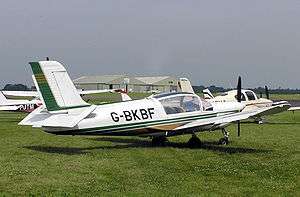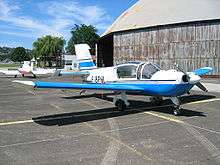SOCATA Rallye family
| Rallye | |
|---|---|
 | |
| Morane-Saulnier (Socata) Rallye Minerva MS.894A | |
| Role | Tourer/trainer aircraft |
| National origin | France |
| Manufacturer | SOCATA |
| First flight | 10 June 1959 |
| Introduction | 1961 |
| Produced | 1961-1982 |
| Number built | ~3,300[1] |
|
| |
The SOCATA Rallye was a light aircraft manufactured in France by SOCATA, beginning in the 1960s. It was originally by Morane-Saulnier as the MS.880. It was eventually replaced in production by the Socata TB series in the 1980s, but continued in production in Poland under licence by PZL as the PZL Koliber.
Design
The Rallye is a single-engined, low-wing monoplane of all metal construction, fitted with a fixed landing gear. Tricycle landing gear (free-castering nosewheel, main gear width of 6' 7" or 2.0 m)[2] is standard in all variants except the 235 C, which is available with fixed tailwheel landing gear. Power was from one of a range of progressively more powerful air cooled engines, ranging from a 100 hp (75 kW) Continental O-200-A engine in the Rallye Club, to a 235 hp (175 kW) Lycoming O-540 in the Rallye 235. It has a bulbous cockpit which can accommodate two/three people in the basic lower-powered variants and four in the more powerful aircraft, some of which are designed to be used as glider tugs.
The cantilever wing incorporates nearly full-span automatic leading edge slats, wide-chord slotted ailerons, and wide-span Fowler-type trailing edge flaps.
History
In 1958, Morane-Saulnier designed a single-engined light aircraft, the MS.880 Rallye Club,in response to a French government competition. The prototype, powered by a 90 hp (67 kW) engine, first flew on 10 June 1959. The first versions, the MS.880B and more powerful MS.885, were certified as airworthy on 21 November 1961.[3]
Morane-Saulnier became part of Sud Aviation in 1965, and was renamed Socata[4] in 1966, continuing to build the Rallye in large numbers through the remainder of the 1960s and through the 1970s.[1] In 1979 Socata embarked on a new production program, and renamed the Rallye series, with each model getting an individual, "more Gallic" name.[5] They were gradually replaced during the 1980s in French production by the Socata TB series, the last (of approximately 3,300[1]) aircraft built by Socata, an armed R235 Guerrier, being delivered in December 1984.[6]
This was not the end of Rallye production however, as Socata had sold a license for production of the Rallye 100ST to the Polish State aviation company PZL, the aircraft being produced in its Warsaw factory as the PZL Koliber (Humming Bird). The first PZL built aircraft flew on 18 April 1978, entering production in 1979, with ten being produced that year.[7]
Variants
French production
- MS.880
- Original production version. Powered by 100 hp (75 kW) Continental O-200. Two-seat aircraft.
- MS.881
- 105 hp (78 kW) Potez engine. 12 built.[3] Two-seat aircraft.
- MS.883
- 115 hp (86 kW) Lycoming engine. 77 built.[3] Two-seat aircraft.
- MS.885 Super Rallye
- Two/three-seat version; first flight 1 January 1961.[8] 145 hp (108 kW) Continental O-300 engine. 212 built.[3]
- MS.886
- 150 hp (110 kW) Lycoming engine. Three built.[3]
- MS.890 Rallye Commodore
- The first version to incorporate four-place seating.[8] 145 hp (108 kW) Continental engine. Eight built.[3]
- MS.892 Rallye Commodore 150
- Similar to the MS.890 but with 150 hp (110 kW) Lycoming 0-320 engine. Later designated Rallye 150.
- MS.893 Rallye Commodore 180
- 180 hp (130 kW) Lycoming O-360 engine. Later designated Rallye 180. Further redesignated SOCATA Gaillard or SOCATA Galérien (glider towing version).
- MS.894 Rallye Minerva
- 220 hp (160 kW) Franklin 6A-350 engine. Later designated Rallye 220. Sold as Waco Minerva in United States.
- Rallye 100
- Powered by 100 hp (75 kW) Rolls-Royce Continental O-200. Available in two-seat trainer/sport (100-S) stressed for aerobatics, four-seat tourer (100-T) or convertible two/four-seat version (100-TS).
- Rallye 125
- Four-seat version of 100-T, powered by 125 hp (93 kW) Lycoming O-235.
- Rallye 235
- Powered by 235 hp (175 kW) Lycoming O-540. Redesignated SOCATA Gabier.
- SOCATA Galopin
- Version of Rallye 100 powered by 110 hp (82 kW) Lycoming O-235. Original designation Rallye 110.[9] Can be operated as a three/four-seat aircraft if spins are prohibited. All the other variants beginning with the MS.890 are full four-seat aircraft.[10]
- SOCATA Garnement
- Improved version of Rallye 150, with 155 hp (116 kW) Lycoming 0-320.[9]
- SOCATA Gaucho
- Tailwheel agricultural aircraft.[9]
- SOCATA R235 Guerrier
- Military version of Gabier/Rallye 235.
- SOCATA Gaillard
- Rallye 180 renamed
- SOCATA Galérien
- Glider tug or banner-towing version of the Rallye 180
- SOCATA Gabier
- renamed Rallye 235
- Waco Minerva
- Sales of the Rallye Minerva in the USA
Polish production
- PZL-110 Koliber
 PZL-110 Koliber
PZL-110 Koliber - Initial licence production version powered by PZL licensed 116 hp (87 kW) Franklin 4A-235, based on Rallye 100 ST.[7] Production 32 aircraft.[11]
- PZL-110 Koliber 150
- 150 hp (110 kW) Lycoming O-320 engine.[11]
- PZL-110 Koliber 160
- 160 hp (120 kW) Lycoming O-320 engine.[11]
- PZL-111 Koliber 235
- 235 hp (175 kW) Lycoming O-520 engine.[11]
Operators
Military operators
Civil operators
Specifications (180 GT)

Data from Jane's All the World Aircraft 1976-77[21]
General characteristics
- Crew: one pilot
- Capacity: three passengers
- Length: 7.24 m (23 ft 9 in)
- Wingspan: 9.74 m (31 ft 11 in)
- Height: 2.80 m (9 ft 2¼ in)
- Wing area: 12.3 m² (132 ft²)
- Empty weight: 570 kg (1,257 lb)
- Max. takeoff weight: 1,050 kg (2,315 lb)
- Powerplant: 1 × Lycoming O-360-A3A air cooled flat four piston engine, 134 kW (180 hp)
Performance
- Maximum speed: 240 km/h (129 knots, 149 mph)
- Cruise speed: 225 km/h (121 knots, 140 mph)
- Stall speed: 92 km/h (50 knots, 57.5 mph)
- Range: 1,300 km (702 nm, 807 mi)
- Service ceiling: 3,600 m (11,800 ft)
- Rate of climb: 3.85 m/s (758 ft/min)
- Wing loading: 85.4 kg/m² (17.5 lb/ft²)
- Power/mass: 0.13 kW/kg (0.078 hp/lb)
References
- 1 2 3 Donald 1994, p. 804.
- ↑ Brechner, Berl, The Rallye 235 GT, AOPA Pilot October 1977, pages 38-42.
- 1 2 3 4 5 6 Taylor, 1976, p. 64
- ↑ The Society de Construction de Tourisme et d'Affaires - pilotfriend.com
- ↑ "Rallye History". Fly Rallye. Retrieved 3 August 2008.
- ↑ Taylor 1988, p. 84
- 1 2 Taylor 1988, p. 193.
- 1 2 Pilotfriend.com, Aerospatiale-Socata Rallye, retrieved 27 January 2014
- 1 2 3 "The Socata Rallye" airliners.net. Retrieved 4 August 2008.
- ↑ Mondey
- 1 2 3 4 Taylor, M.J.H. 1999, p.453.
- ↑ Gaines Flight International 6 November 1982, p. 1360.
- ↑ Gaines Flight International 6 November 1982, p. 1366.
- ↑ Wheeler Flight International 6 August 1983, p. 336.
- ↑ Gaines Flight International 6 November 1982, p. 1387.
- ↑ Gaines Flight International 6 November 1982, p. 1330.
- ↑ Hatch Flight International 5–11 December 1990, p. 60.
- ↑ Hatch Flight International 5–11 December 1990, p. 61.
- 1 2 Hatch Flight International 5–11 December 1990, p. 68.
- ↑ Wheeler Flight International 6 August 1983, p. 367.
- ↑ Taylor 1976, pp.65-66.
Bibliography
- Donald, David (editor). The Encyclopedia of World Aircraft. Leicester, UK: Blitz, 1997. ISBN 1-85605-375-X
- Gaines, Mike. "World's Air Forces 1982". Flight International, 6 November 1982. Vol 122, No. 3835. pp. 1327–1388.
- Hatch, Paul "World's Air Forces 1990". Flight International, 5–11 December 1990. Vol. 138, No. 4245. pp. 35–81.
- Mondey, David. Encyclopedia of The World's Commercial and Private Aircraft. New York NY, USA. Crescent Books (1982)
- Taylor, John W R. (editor). Jane's All the Worlds Aircraft 1976-77. London:Jane's Yearbooks, 1976. ISBN 0-354-00538-3
- Taylor, John W R. (editor). Jane's All the Worlds Aircraft 1988-89. Coulsdon, Surrey, UK: Jane's Information Group, 1988. ISBN 0-7106-0867-5
- Taylor, Michael J.H. (editor). Brassey's World Aircraft & Systems Directory 1999/2000 Edition. London:Brassey's, 1999. ISBN 1-85753-245-7
- Wheeler, Mike. "World's Air Forces 1983". Flight International, 6 August 1983. Vol 124, No. 3874. pp. 313–380.
External links
| Wikimedia Commons has media related to Morane-Saulnier Rallye. |